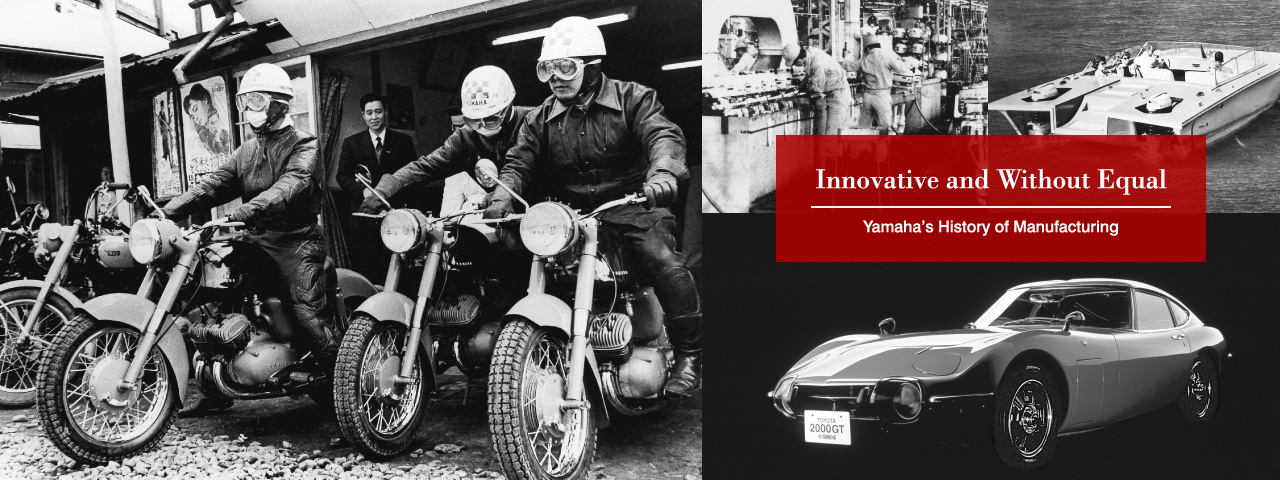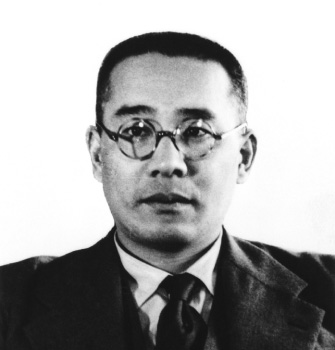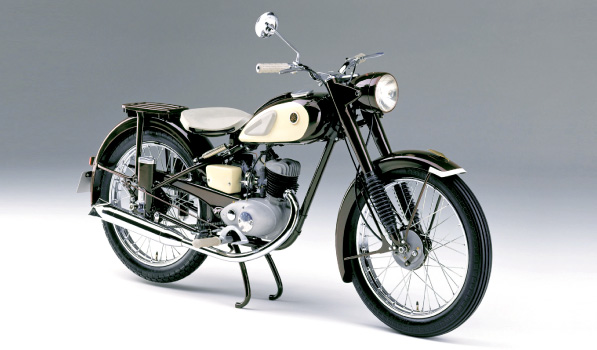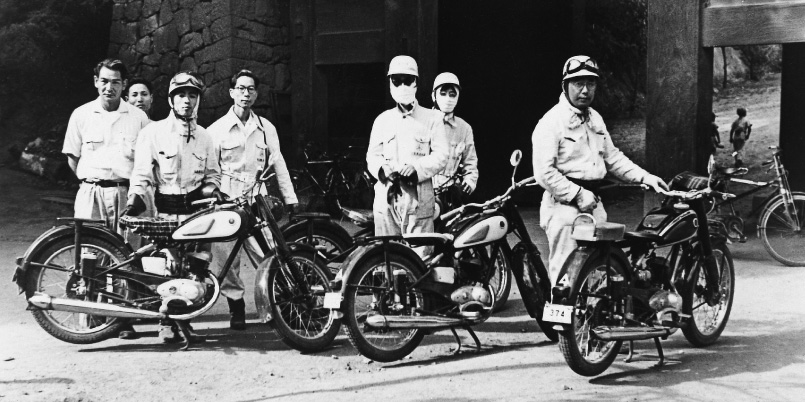Our History of Casting Vol. 1 - In the Beginning
Manufacturing is the cornerstone of Yamaha's business and we continue to refine our casting technology. This is the story of how these technologies join the present with the future.



Manufacturing as a Foundation for Growth
Diverse and Unique
Yamaha Motor produces an extensive range of high-quality products,
and the importance we place on our manufacturing base
and honing our technical expertise is what makes this possible.
This heritage began with our founding and continues to this very day.
“Broadminded” is the word that describes Genichi Kawakami, the founder of Yamaha Motor. A man of strong character possessing a decisive management style unconstrained by convention, Kawakami recognized early on the importance of raw materials and metalworking, and was himself an engineer with uncommon fervor. Yamaha's corporate culture of meticulous care toward the materials and manufacturing methods employed for creating products was born and fostered by Kawakami in the company's earliest days, and continues unchanged today.
Yamaha Motor's history is somewhat complicated. Kawakami founded Yamaha Motor in 1955 and served as its first president while also serving as the president of Nippon Gakki Co., Ltd. (today's Yamaha Corporation). The name these two companies share today has its roots in the Yamaha Organ Manufacturing Company, a joint-stock company founded in Hamamatsu, Shizuoka Prefecture by Torakusu Yamaha in 1889. Initially manufacturing Japan's first organs, the company was reorganized as Nippon Gakki Co., Ltd. in 1897, and steadily grew and prospered as Japan's only musical instrument manufacturer.

Genichi Kawakami when he became Yamaha Motor's first president in July 1955
Genichi Kawakami was 38 years old when he became Nippon Gakki's fourth president in 1950. Kawakami brought new wind to the company's sails with his creative approach to management, strengthening and reorganizing the company's corporate structure, improving the efficiency and productivity of the production lines, and more. Under his leadership, Nippon Gakki became the world's leading piano manufacturer in terms of volume.
On November 7, 1953, Kawakami issued a highly confidential directive to the members of Nippon Gakki management to begin building a prototype motorcycle engine. At the time, Nippon Gakki had no experience manufacturing motorcycle engines, but the company did have the technical resources to do so.
During World War II, Nippon Gakki manufactured wooden and metal propellers for airplanes, and had also built an engine to test them. The company also had its casting technology for making piano frames to rely on. The taut strings of a piano apply close to 20 tons of force, meaning a piano frame must not only have the rigidity to withstand this but also have the right elasticity to flex (vibrate) and produce high-quality sound. Rigidity and elasticity — Nippon Gakki had the casting know-how to achieve these two seemingly mutually exclusive qualities in a single item.
Kawakami's order to produce a prototype motorcycle engine was the result of both his foresight and his objectives. He wanted to utilize the company's available technological assets, find a use for the company's machinery for making propellers that had been sitting dormant since the end of the war, and to further grow Nippon Gakki's business by manufacturing products other than musical instruments. These management decisions perfectly overlapped with Kawakami's own innate fascination and love of vehicles, including motorcycles.
In the mid-1950s, there were some 200 motorcycle manufacturers in Japan all vying for supremacy, so Nippon Gakki was among the later arrivals. Unsurprisingly, some in the company expressed unease at the prospect of entering the motorcycle industry. However, after touring various countries overseas, Kawakami said, “If we can build a world-class motorcycle, we can definitely be competitive.” He saw a painstaking dedication to quality as the path to success with motorcycles.
By 1954, work on the first prototype motorcycle was underway. Having to start from zero made this a very challenging project. The first cylinders were sand-cast and came out as ugly lumps of iron and were jokingly called “clay teapots.” They were far too unattractive, since cylinders are part of a motorcycle's exterior appeal. Only after exhaustive trial-and-error did the engineers succeed in making high-precision castings for the time.
Their guiding mantra was: whatever we can make ourselves, we should make. The team's diligence toward refining their manufacturing technology—the very foundation for the Monozukuri approach of engineering, manufacturing and marketing products with an emphasis on craftsmanship and excellence—combined with their dedication to superior performance and design quality resulted in the company's first motorcycle, the 125cc Yamaha YA-1. Completed and shipped on February 11, 1955, it had been only eight months since they decided what bike to model the YA-1 after. It was a perfect example of President Kawakami's motto of “To work carefully is to work quickly.”

The YA-1, nicknamed the Akatombo (Red Dragonfly)
At a time when the starting monthly salary for a male college graduate was about 10,000 yen, the YA-1's price tag was a whopping 138,000 yen. For a late-arriving manufacturer like Nippon Gakki, sales were hard to come by at first. But a combination of things like the YA-1's attractive design, quick engine starts and racing successes proving its performance bore fruit, and the greater brand recognition that followed eventually led to steady sales and production.
On July 1, 1955, Nippon Gakki spun off its motorcycle-related sales and manufacturing divisions and established Yamaha Motor Co., Ltd. However, since Kawakami served as the president of both and the headquarters of the new motorcycle company was located within Nippon Gakki's grounds, it was still viewed as a division of Nippon Gakki by both employees and customers alike in those early days.
However, things changed very quickly after Yamaha Motor was founded. The fast-improving economy and accompanying boom in motorcycles led to a rapid expansion of the company's sales and business. And as one would expect, underpinning this sudden growth were the company's casting and other manufacturing technologies, a fact that President Kawakami was well aware of. (Continues in Vol. 2)

Our Business
We apologize for any inconvenience caused and we are hoping for your kind consideration.